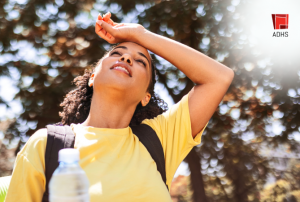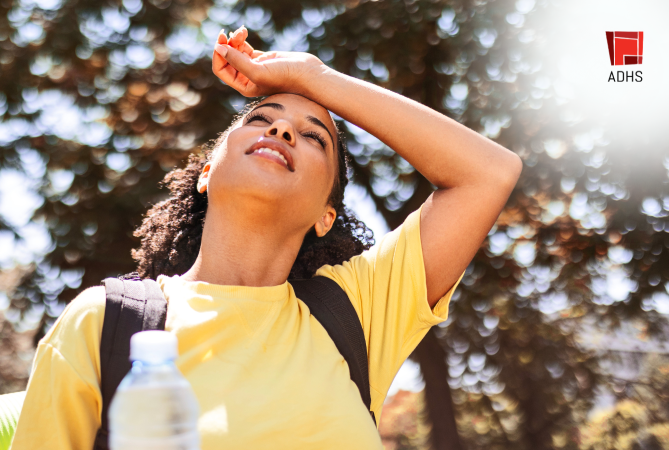 Arizona’s been experiencing record-breaking high temperatures and a slow-to-start monsoon season. We’ve seen Excessive Heat Warnings in every county and Phoenix specifically is experiencing a record- breaking summer, with more than 26 consecutive days of 110+ degree weather so far (and it’s only July!)
Arizona’s been experiencing record-breaking high temperatures and a slow-to-start monsoon season. We’ve seen Excessive Heat Warnings in every county and Phoenix specifically is experiencing a record- breaking summer, with more than 26 consecutive days of 110+ degree weather so far (and it’s only July!)
It’s vital to stay cool and hydrated in this heat and we’re thankful to statewide resources including cooling centers, Arizona 2-1-1, and LIHEAP community assistance programs for keeping people safe this summer.
Frequent triple digit temperatures (which typically last from May through September in Arizona) and exposure to excessive natural heat can result in an increased risk for heat-related illness. Heat-related illnesses (HRI) range from heat cramps and heat exhaustion to heat stroke, which can be fatal without immediate care.
According to ADHS’ Heat-related Illness (HRI) Dashboard, hospital visits for HRI have been increasing week after week. During the week of July 16, 2023 alone, 570 hospital visits were recorded for HRI. Fire departments and Emergency Medical Service (EMS) providers have reported treating an increasing number of patients for heat-related illness too. These incidents are only the tip of the iceberg. We urge Arizonans to take this extreme heat extremely seriously.
Stay cool, stay hydrated, and stay informed
Anyone can be susceptible to heat-related illness. Protect yourself and your loved ones by making sure you are drinking enough water and limiting your exposure to the heat. Don’t forget to check on your neighbors and older adults during this time. ADHS collaborates with multiple partners as part of the Heat Relief Network to prevent heat-related illnesses and death. Cooling centers and hydration stations are available throughout the state to provide respite from the heat.
- Drink water. Always carry water with you and drink even if you do not feel thirsty. Avoid alcohol which dehydrates the body. Avoid using salt tablets unless directed to do so by a physician. We recommend drinking at least two liters (eight or more cups) of water each day, even if you are mostly indoors. Outdoor workers, anyone who is outside in high temperatures, those engaging in physical activity, and individuals who have certain health conditions should increase their intake.
- Dress for the heat. Wear lightweight, light-colored clothing, wear hats or use an umbrella, and always apply sunscreen to exposed skin.
- Never leave children, adults, or pets inside a parked vehicle. A parked vehicle can reach dangerous temperatures in just minutes. Leaving the windows down or parking under shade is not enough to protect your loved ones.
- Be aware of hot concrete. On a hot day, asphalt can be 40 to 60 degrees hotter than the temperature.
- Don’t leave perishable food out. If the temperature is above 90 degrees, don’t leave perishable food out for more than an hour. Make grocery shopping the last stop, and don’t leave groceries in hot cars. Bring insulated bags, ice packs, or coolers to keep food cold. While in the store, shop for your nonperishable items first, and bag frozen items with perishables.
- Refrigerate fruits and vegetables after cutting them if not consumed immediately.
- Monitor those at high risk. Check on friends, family, and neighbors for signs of heat exhaustion or heat stroke. Infants and young children require much more frequent observation. Respectfully check on elderly neighbors to ensure their air conditioning is working and in use.
- Slow down. Avoid strenuous activity. If you must do strenuous activity, do it during the coolest part of the day, which is usually in the morning between 4:00 a.m. and 7:00 a.m.
- Stay indoors when possible. An air-conditioned room can keep you cool. Maricopa, Pima, Pinal, and Yuma counties have established air-conditioned sites as free cooling centers for those needing shelter. Some will let you bring your pets; check the rules before you go.
- Take regular breaks when engaged in physical activity on warm days. Take time out to find a cool place. If you recognize that you, or someone else, are showing symptoms of a heat-related illness, stop activity and find a cool place. Remember, have fun, but stay cool!
- Check your heat risk and the UV Index. Get a better sense of the heat’s potential impact on your health. The National Weather Service’s Heat Risk Map provides a forecast for the risk of heat-related impacts to occur over a 24-hour period. The Environmental Protection Agency’s UV Index provides a forecast of the expected risk of overexposure to UV radiation from the sun.
- Sign up for ADHS Excessive Heat Warnings. Sign up to get messages from ADHS whenever there’s an Excessive Heat Warning and to get tips on staying safe and cool.
Resources
-
- Cooling Centers and Hydration Stations: Cooling centers and hydration stations provide respite to people from the heat
- Arizona 2-1-1: Can assist in locating and finding transportation to nearest Heat Relief location and help identify options for bill payment assistance or home weatherization and rehabilitation services.
- Low Income Home Energy Assistance Program (LIHEAP) helps low income households pay their heating/cooling bills, minimize crises, and make energy costs more affordable.
- The Arizona Department of Economic Security offers programs and services to help find shelter and housing during a time of need. Services include short-term crisis services for low-income families, resources and services for the unhoused, and utility assistance.
- Older Adult Toolkit
- School Toolkit
- Outdoor Worker Toolkit
- Heat Safety Resource Guide
We plan to share additional heat safety resources in the coming weeks on our blog, website, and social media. Sign up to receive heat alerts from ADHS and stay safe.










